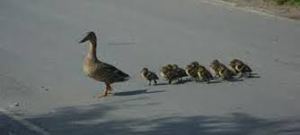I looked out our kitchen window one morning and saw what looked like the front legs of a very large dog in the yard next door. I went to another window to look more closely and was startled to see a doe standing there. Very shortly thereafter, the doe ran off — leaping across the street out front, presumably on her way to find a place more wild than someone’s backyard.
We live fairly close to the 1200-acre UW-Arboretum and every so often we see creatures from “the wild” around the neighborhood: a fox, wild turkeys, a baby ‘possum (in our window well), a ground hog (ugh), ducks, racoons, and — just that one time — a deer.
I felt a kind of thrill at seeing the doe that morning. For those of us who live in urban settings, there is something about spotting a comparatively “wild” thing on our home territory that stirs excitement. I told my deer tale to a number of people on that day. [And here I am, telling it again!] My friend Melinda, wanting to share her moment with the wild things, posted a picture on Facebook of five wild turkeys that wandered into her yard one day last year. Our son and his family live in a nearby residential area on the edge of Madison and they tell us about turkeys and at least one fox walking through their back yard regularly. Recently, a turkey roosted on their garage roof for the night, providing a new novel detail for their turkey tales.
Robert Macfarlane wrote a book about his journey to find the wild places that still exist in England, Scotland, Ireland and Wales (The Wild Places, Penguin Books, 2007). The book is beautifully written. In the book, Macfarlane says this: “Wildness . . . is an energy which blows through one’s being, causing the self to shift into new patterns, opening up alternative perceptions of life” (p. 209). He searches back into ancient Chinese history to describe the more than 2,000 year old concept of a love for the wild. He speaks of this love as a quality of aliveness, a “self-ablazeness.” What a fantastic word!
One day, when I was still on faculty full-time, I was walking along University Avenue to get back to my office. University Avenue is a very heavily used roadway that cuts right through the University campus. It has a bus lane, two bike lanes and three auto lanes. It’s always busy. As I was walking, I suddenly heard a screeching of brakes and some commotion back behind me. I turned around to look, and saw a car that had come to a halt sort of crosswise on the Avenue, blocking other cars from going through. And then I saw what had prompted this driver to put himself in such a dangerous situation — a mother duck and her baby ducks were in the middle of University Avenue, making their way across the road, directly in front of the car. It was a transformative moment, it seemed like everyone held their breath as the little family calmly went about getting across the street, up the curb and then finally heading toward the nearby lake.

These are the bits of wild things that come into the lives of those of us who live in urban settings. For some people, it is not enough. They buy a cottage on a lake up north to escape to during the summer days, anticipating refreshment for body and spirit. One young family I know has a canvas yurt permanently located in Upper Michigan to which they retreat regularly. Some people just go for drives or hikes in the country and others pull up their city roots and actually move to the country.
Aldo Leopold, a Wisconsin son and one of the world’s greatest naturalists, has said, “There are some who can live without wild things, and some who cannot.” (A Sand County Almanac (Oxford University Press, 1949, p. vii). Maybe so. But to live without any wild things would seem like a bleak and wanting existence. Even though we are limited to “bits” of wildness in our urban settings, we do at least have occasional moments when our spirits are lifted and we feel “ablaze.”
